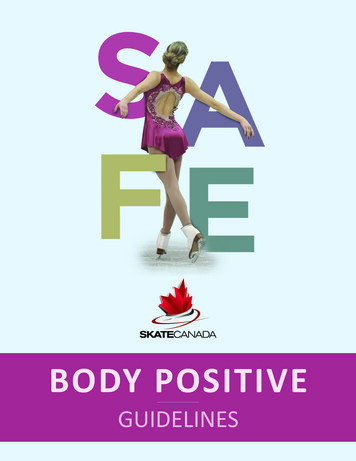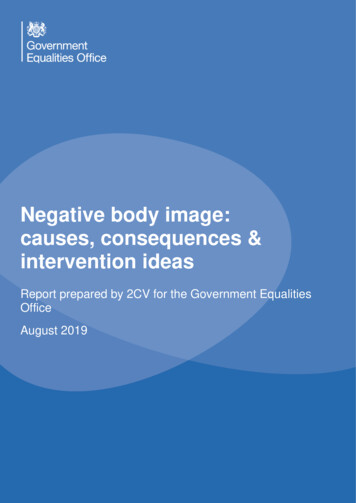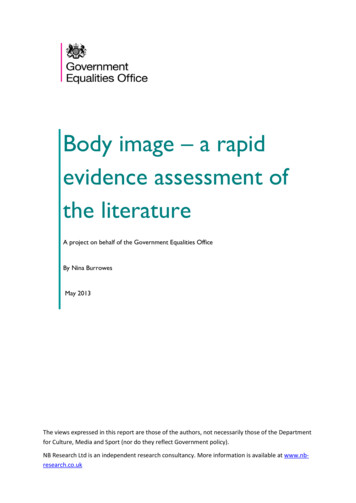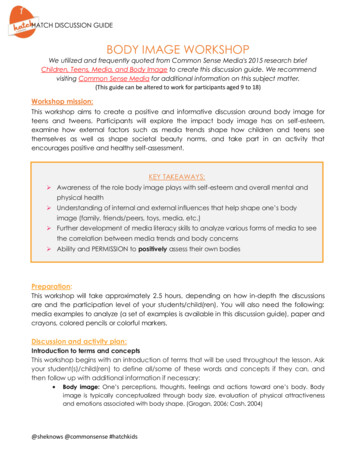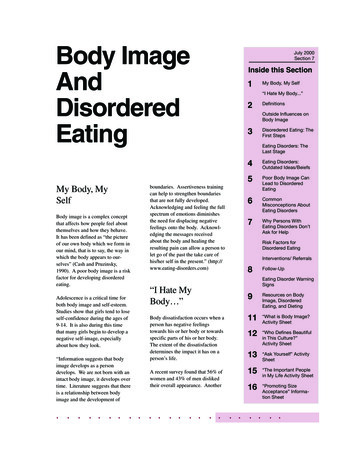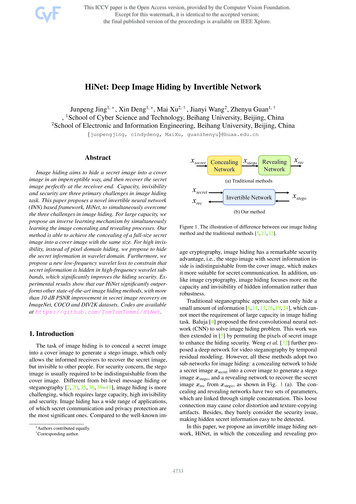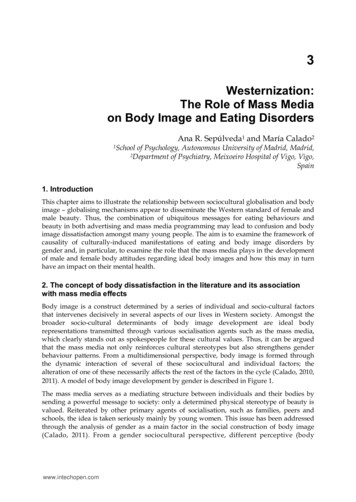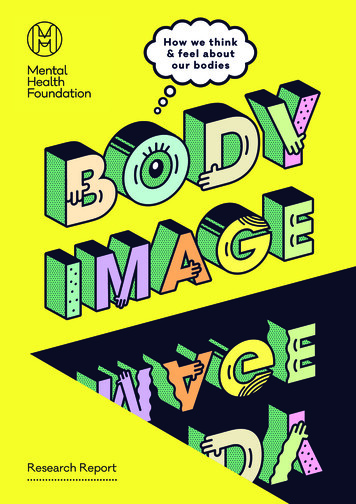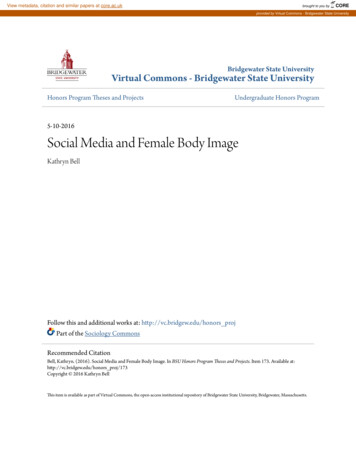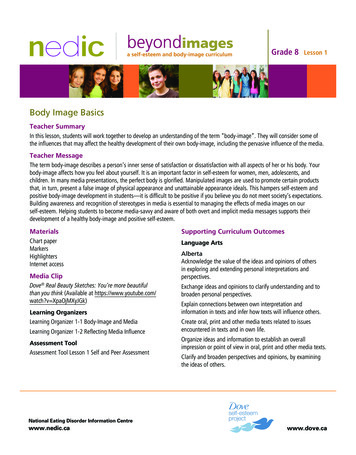
Transcription
Grade 8Lesson 1Body Image BasicsTeacher SummaryIn this lesson, students will work together to develop an understanding of the term “body-image”. They will consider some ofthe influences that may affect the healthy development of their own body-image, including the pervasive influence of the media.Teacher MessageThe term body-image describes a person’s inner sense of satisfaction or dissatisfaction with all aspects of her or his body. Yourbody-image affects how you feel about yourself. It is an important factor in self-esteem for women, men, adolescents, andchildren. In many media presentations, the perfect body is glorified. Manipulated images are used to promote certain productsthat, in turn, present a false image of physical appearance and unattainable appearance ideals. This hampers self-esteem andpositive body-image development in students—it is difficult to be positive if you believe you do not meet society’s expectations.Building awareness and recognition of stereotypes in media is essential to managing the effects of media images on ourself-esteem. Helping students to become media-savvy and aware of both overt and implicit media messages supports theirdevelopment of a healthy body-image and positive self-esteem.MaterialsChart paperMarkersHighlightersInternet accessMedia ClipDove Real Beauty Sketches: You’re more beautifulthan you think (Available at https://www.youtube.com/watch?v XpaOjMXyJGk)Learning OrganizersLearning Organizer 1-1 Body-Image and MediaLearning Organizer 1-2 Reflecting Media InfluenceAssessment ToolAssessment Tool Lesson 1 Self and Peer AssessmentSupporting Curriculum OutcomesLanguage ArtsAlbertaAcknowledge the value of the ideas and opinions of othersin exploring and extending personal interpretations andperspectives.Exchange ideas and opinions to clarify understanding and tobroaden personal perspectives.Explain connections between own interpretation andinformation in texts and infer how texts will influence others.Create oral, print and other media texts related to issuesencountered in texts and in own life.Organize ideas and information to establish an overallimpression or point of view in oral, print and other media texts.Clarify and broaden perspectives and opinions, by examiningthe ideas of others.National Eating Disorder Information Centrewww.nedic.cawww.dove.ca
Grade 8Lesson 1Evaluate the quality of own contributions to groupprocess, and offer constructive feedback to others; proposesuggestions for improvement.Write meaningful personal texts that explore ideas andinformation to express self, make connections, and reflectand respond.Atlantic ProvincesConsider and reflect upon the contribution of others’ ideasduring discussions.Write and represent to synthesize and extend thinking,by personalizing ideas and information and explainingrelationships among ideas and information.State a point of view in a convincing manner, offering relevantinformation to support that viewpoint.ManitobaIntegrate new understanding with previous viewpoints andinterpretations.Contribute to small-group conversation and whole-groupdiscussion, choosing appropriate strategies that contribute toeffective talk.Elaborate personal reactions to what is read and viewedby providing some extended explanations, examples, andsupporting arguments.State personal points of view about what is read and viewedand justify views with increasing regularity.Recognize that texts need to be assessed for bias, andbroaden their understanding and awareness of the ways inwhich print and media texts can be biased; begin to questionand think critically about the relevance and reliability ofinformation when answering questions and inquiries.British ColumbiaInteract and collaborate in pairs and groups to support thelearning of self and others and explore experiences, ideas, andinformation.Read, both collaboratively and independently, to comprehenda variety of information and persuasive texts with somecomplexity of ideas and form, such as articles and reports.View, both collaboratively and independently, to comprehenda variety of visual texts, such as film and video.After reading and viewing, select and use a range ofstrategies to extend and confirm meaning, includingresponding to text.Articulate, represent, and explain personal viewpoints clearly.Reconsider initial understanding in light of new information,and ask clarifying questions; listen to diverse opinions andrecognize ambiguity.Express personal reactions to a variety of experiences andtexts and compare them with the reactions of others.Evaluate the quality of own contributions to group processand set goals and plans for development of personal skills;evaluate group process and plan for growth.OntarioDemonstrate an understanding of appropriate listeningbehaviour by adapting active listening strategies to suit awide variety of situations, including work in groups.Demonstrate an understanding of the information and ideasin increasingly complex and difficult oral texts in a varietyof ways.Demonstrate an understanding of appropriate speakingbehaviour in most situations, using a variety of speakingstrategies and adapting them to suit the purpose andaudience.Develop and explain interpretations of increasingly complex ordifficult texts using stated and implied ideas from the texts tosupport their interpretations.Explain and support personal responses to texts, by makingconnections with prior knowledge and experiences, describingreactions and emotions, and developing opinions using evidence.Extend understanding of texts, including increasingly complexor difficult texts, by connecting the ideas in them to their ownknowledge, experience and insights, to other texts, and to theworld around them.Synthesize and extend thinking about texts, by personalizingideas and information.Evaluate the effectiveness of a text based on evidence takenfrom that text.2
Grade 8Lesson 1QuébecUse teamwork effectively and contribute to team efforts.Use collaborative talk purposively in order to seek multipleperspectives on the issue and extend understanding of theissue or topic by building on the ideas of others.SaskatchewanView, listen to, read, comprehend, and respond to a variety oftexts that address identity, social responsibility, and efficacy.View critically and demonstrate comprehension of avariety of visual and multimedia texts including videos,television broadcasts, informational presentations, dramaticpresentations, websites, and news programs to locate andinterpret key messages and details, to develop conclusions,opinions, and understanding, and to evaluate theeffectiveness of the text.Use oral language to interact purposefully, confidently, andrespectfully in a variety of situations including one-to-one,small group, and large group discussions.3
Grade 8Lesson 1Lesson Outline1. Post the term “body-image” on the whiteboard or chart paper in front of the class.2. Ask students to brainstorm ideas, images, and words that come to mind when they hear the term“body-image.” Jot down, or have a student jot down, as many of the ideas as possible.Facilitation: How will students learn the concepts?3. Arrange students in groups of two, three, or four and provide each group with chart paper, markers, andhighlighters.4. Ask students to use the results of the brainstorming and their own ideas to create a mind map showingthe variety of ideas, terms, and images linked to body-image. Remind students that a mind map is a visualorganization of key ideas related to a key term (in this case “body-image”). Major ideas are connected to the key termand then associated ideas branch out from the major ideas. Students may organize their thinking using key ideas such asdevelopmental factors (for example, heredity and puberty) and social influences (for example, peers, media, and parents), orideas of their own.5. Post the mind maps that groups create around the classroom and conduct a gallery walk for students toview each group’s mind map. Ask students to note ideas that were new to them, ideas that resonated with them, andideas that they may not agree with.6. Debrief as a whole class. Lead a discussion about the mind maps. Ask students to consider the following questions: What were some similarities between the maps? Were there any terms or ideas that were new to you? What ideas did you see that really resonated with you? Were there any ideas that you disagree with? What would you like to know more about?7. Have students read the article on Learning Organizer 1-1 Body-Image and Media silently to themselves.Application: How will students demonstrate their learning?8. Ask students to answer the questions on the second page of Learning Organizer 1-1 after reading the article.Reflection: How will students reflect on their learning?9. Play Dove Real Beauty Sketches: You’re more beautiful than you think for students (Available at https://www.youtube.com/watch?v XpaOjMXyJGk). You may wish to play it more than once to allow students to consider the nature ofthe differences between women’s perceptions of themselves and the way others see them. Invite volunteers to share someinsights they gained from the video.10. Have students complete a self reflection by answering the questions on Learning Organizer 1-2 Reflecting onMedia Influence. Students may write a journal entry based on their answers to these questions and other key ideas theyencountered in the lesson.4
Grade 8Lesson 1AssessmentYou may choose to have students use Assessment Tool Lesson 1 How well did we to reflect on peer and selfengagement during this lesson.Related Resources to Extend LearningBest Bets for Teachers:Dove Self Esteem Project: (http://selfesteem.dove.ca/en/)This website was designed to provide education programs and fun interactive activities that help girls overcome beauty-relatedanxieties that can prevent them from developing confidence and positive self-esteem.Media Smarts: (www.mediasmarts.ca)MediaSmarts is a Canadian not-for-profit charitable organization for digital and media literacy. Their vision is that children andyouth develop the critical thinking skills to engage with media as active and informed digital citizens.Best Bet for Students:Collins-Donnelly, K., 2014. Banish Your Body Image Thief: A Cognitive Therapy Behaviour Workbook on Building Positive BodyImage for Young People. ISBN 978-18490546385
Grade 8Learning OrganizerLesson 1-1Body-Image and MediaName:Date:Unrealistic Standard of BeautyIt is no secret that we live in a weight and appearance obsessed culture. Kids today are inundated with images of Hollywoodstars that project an unrealistic and unattainable standard of beauty. It doesn’t help that advertisements touting diet fads andworkouts promise young people that they can achieve the “perfect look,” and perfect life, if they try.What Does the Research Say?We know from the research that appearance-oriented media (like reality TV, celebrity magazines and websites) are immenselypopular among young people and can produce and sustain body dissatisfaction in children. Upwards of 70% of adolescentgirls say that images in fashion magazines influence their self-image and nearly half say those pictures make them want to diet.Young women’s self-esteem drops dramatically after only a few minutes of reading these magazines.Of course, body-image isn’t just an issue for girls. Young men experience an increase in depression and body dissatisfaction afterexposure to ads featuring a muscular male body ideal. In addition, video games increase a drive for muscularity among boys asyoung as 7.Media Literacy: an Antidote to Negative Body-ImageThe good news is that parents and teachers do make a difference! Elementary school children reported a significant increasein body esteem two weeks after a single lesson explaining how media use technology and fantasy to construct unrealisticand unhealthy beauty images. Talk with your kids about the images, slogans, and messages they consume to help counteractunhealthy body images.Discussion Questions1. Do you regularly compare your appearance, weight, or shape to what you see in media?2. List all of the things that your body does for you. Are all of these qualities reflected in the media? Why or why not?3. Do the women and men you see in the media have similar body types to the people in your life you admire?4. What sort of strategies do advertisers use to create the perfect look? (Hint: airbrush, photoshop etc )5. Do you feel like your identity and value is based on how you look? Why or why not? National Institute on Media and the Family
Grade 8Learning OrganizerLesson 1-2Reflecting on Media InfluenceName:Date:Use this organizer to reflect on what you have learned about body-image and media influence. Consider thefollowing questions:1. How well do the images I see in the media reflect me? Do they reflect my physical appearance? Do they reflect my interestsand my experiences?2. How do I feel about the images I view on a daily basis? Do I feel represented?3. What is media telling me? What is it telling my friends and peers?
Grade 8Assessment ToolLesson 1Self and Peer AssessmentName:Date:PART A: PEER ASSESSMENTWrite the name of each member of your group at the top of one column. Assess how well you worked together. Respond toeach question on the left for each group member by circling E (Excellent), G (Good), S (Satisfactory), or N (Needs Improvement).Names:1. How well did groupmembers ask questions toclarify meaning and ensureunderstanding?2. How willingly did groupmembers work with othergroup members?3. How well did group memberslisten, acknowledge, andconsider differing opinions?4. How well did group memberstake NNNNEEEEGGGGSSSSNNNNPART B: SELF ASSESSMENTHow did you show that you were on task and engaged in this lesson?
The term body-image describes a person’s inner sense of satisfaction or dissatisfaction with all aspects of her or his body. Your body-image affects how you feel about yourself. It is an important factor in self-esteem for women, men, adolescents, and children. In many media prese
